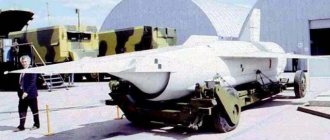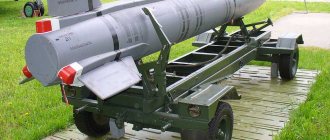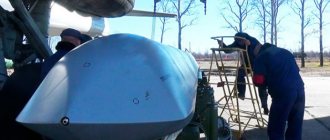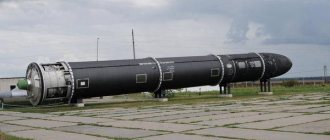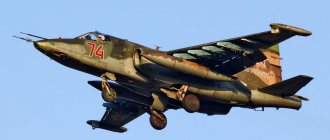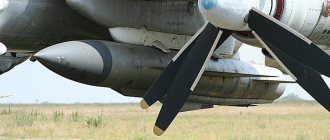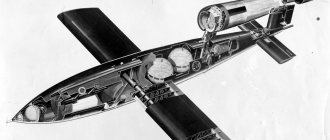X-55 strategic cruise missile.
Strategic cruise missile Kh-55 (RKV-500, product 120).
Developer: MKB "Raduga" Country: USSR Start of development: 1976 Start of mass production: 1980 Adoption into service: 1983
The X-55 is a subsonic, small-sized, air-launched, long-range strategic cruise missile (LSRCM), which flies around the terrain at low altitude and is intended for use against important strategic enemy targets with previously reconnoitered coordinates. The design of a missile system with the X-55 missile began according to the Decree of the USSR Council of Ministers of December 8, 1976 at the Raduga IKB, the chief designer is I.S. Seleznev.
From 1968 to 1970, GosNIIAS carried out the Echo research project, as a result of which it was established that the use of relatively inexpensive long-range subsonic cruise missiles with nuclear warheads, due to stealth and increased accuracy, can be very effective in the air defense system of a potential enemy. The enemy's air defense system could be overcome due to the massive use of missile defense systems with time separation of the raids. The secrecy of such missile launchers could be achieved due to their size, design features, as well as due to low-altitude flight following the terrain. After the intensification of work on the air-launched ALCM missile launcher in the United States in 1975, the leadership of the USSR Ministry of Defense decided to create a similar missile system.
The assembly of prototypes of the Izdeliye 120 missiles began at the Dubninsky Machine-Building Plant in early 1978. Later, due to the plant being loaded with other orders, the transfer of missile production to the Kharkov Aviation Industrial Association began. At the first stage, the production of individual units was carried out at HAPO, which were transferred for assembly to Dubna.
Layout of the first version of product 120.
The first version of the Izdeliye 120 missile was created taking into account the fact that the missiles would be placed in the carrier fuselage on a multi-position ejection unit. Thus, the cross-section of the rocket in the transport position made it possible to make maximum use of the available volume of the carrier aircraft compartment. Later, due to a delay in the creation of a similar KR KS-122 missile for the Navy, the Novator Design Bureau considered the possibility of putting the KR X-55 into service with the Navy and the design of the latter was changed - in the transport position, the cross-section of the missile was inscribed in the dimensions of a 533 caliber torpedo tube mm.
Tests of the cruise missile were carried out at the training ground of the 929th LIC Research Institute of the USSR Air Force in Vladimirovka (Akhtubinsk). The first two experimental launches were unsuccessful.
In March 1978, by decision of the Minister of Aviation Industry V.A. Kazakov, preparations began for serial production of the X-55 rocket at the Kharkov Aviation Industrial Association (KHAPO). Production took place in workshop No. 85 of HAPO under the leadership of A.K. Myalitsa. In December 1979, the first full-fledged rocket fuselage was assembled. The first production rocket, completely manufactured at HAPO, was handed over to the customer on December 14, 1980. A total of 40 Kh-55 missiles were launched for testing during 1981 in Dubna and at HAPO.
Kh-55 cruise missile in the assembly shop of HAPO.
Joint tests of missiles and launch vehicles were carried out on the basis of the route-measuring complex of the test site of the 929th Air Force Research Institute (Akhtubinsk). The experimental carrier aircraft Tu-95M-55 (VM-021) made its first flight on July 31, 1978. The first launch of the X-55 was carried out on February 23, 1981. Until the end of 1981, 10 X-55 launches were carried out from the Tu-95M-55 carrier, and a total of 12 missile launches were carried out during the first stage of flight testing. One of the launches was unsuccessful due to the failure of the rocket's power system generator. On September 3, 1981, a test launch was performed from the first production Tu-95MS. Since March 1982, the second serial Tu-95MS took part in tests in Akhtubinsk. Tests of the X-55 CBBD were completed in December 1982.
Missile carrier Tu-95MS.
The air-launched missile system, including the Tu-95MS carrier and Kh-55 cruise missiles, was put into service on December 31, 1983. Production of the X-55 with HAPO was transferred to the Kirov Machine-Building Plant. The production of X-55 units was also launched at the Smolensk Aviation Plant.
The name of the RKV-500 type missiles was used during the SALT negotiations between the USSR and the USA. In the west, the X-55 missile received the designation AS-15 “Kent”.
Design.
The first version of the rocket, “product 120”, has a normal aerodynamic design, with wings folding under the fuselage and folding tail surfaces. The cross-sectional design of the rocket in the transport position is optimized for placement on a multi-position launcher (“drum”). The engine is located in the fuselage and extends downwards from the fuselage on a pylon before launch. The tail is all-moving, the keel folds to one side. The fuselage design is optimized to reduce radar signature - a sharp nose, a complex cross-sectional profile, placement of the wings under the fuselage in the folded position, a minimum number of holes and protruding elements. It is possible that the skin of the nose of the fuselage, wing and empennage is made of special radio-absorbing materials based on an organosilicon composite (like the later standard version of the rocket).
The basic version of the missile, the X-55, has a normal aerodynamic design, with wings folding into a section of the fuselage (into the fuel tank) and folding tail surfaces. The rocket design has been optimized, incl. for use from a 533 mm torpedo tube. This is due to the fact that due to the delay in the creation of a similar missile system KS-122 for the Navy, the Novator Design Bureau was considering the possibility of putting it into service with the Navy.
Layout diagram of the X-55 missile.
The wing planes fold into the fuselage, placing one above the other. When released, the planes end up at different heights relative to the building horizontal of the product and are fixed at different installation angles, which is why the rocket becomes asymmetrical in the flight configuration. The tail unit is foldable - all its surfaces are all-moving steering surfaces, and the consoles are hinged and broken twice. The keel initially folded on its side (the first version of product 120), but then the consoles were unified and another additional hinge appeared on the keel. To reduce the overall length, the tail spinner was also made retractable, folding like an accordion. When released, the nichrome wire that held it together was burned out by an electric impulse, and the spinner was straightened by a spring. The engine moves down under the action of the squib pusher, after which the opening hatch doors close the opening, squeezing the engine pylon. Pyrotechnic pushers also swung open the wing and empennage consoles, and these mechanisms operated at high pressures of up to 350 atm, literally throwing the units out, where they were held by clamps.
X-55 projections. Scheme.
The rocket was suspended under the launch vehicle using 4 yokes spaced apart throughout the structure, which made it possible to lighten the load-bearing structure of the rocket. The rocket fuselage was made entirely of welded AMG-6 alloy. The wing structure was made of a composite material consisting of silicone fabric and special resin K-1-70.
The fuselage design is optimized to reduce radar signature - the gaps are closed with covers, and there are a minimum number of holes and protruding elements on the surface. The skin of the nose of the fuselage, wing and empennage is made of special radio-absorbing materials based on an organosilicon composite.
The on-board control system BSU-55 is inertial using an on-board computer to correct the flight route in correction areas using the digital altitude matrix of the correction area (extreme navigation). At the correction sections, the rocket's radio altimeter determines the current altitude of the terrain and compares it with the digital height matrix of the correction section in memory - thus determining the location of the rocket in the correction section and the missile control system corrects the flight route to the next correction section. The missile control system ensures stabilization along three axes, development of a given route program, maintaining high-speed and altitude flight modes while performing specified maneuvers to evade interception. Speed and acceleration are monitored by a Doppler speed and drift meter. The control system of the weapons complex on board the carrier ensures obtaining the exact coordinates of the carrier at the time of launch, entering the flight mission and displaying the gyroinertial platforms of cruise missiles.
The design of the engine for a new type of cruise missile was initially undertaken by MNPO Soyuz (Moscow), Omsk IKB and NTK im. N.D. Kuznetsova (Kuibyshev). In addition to the turbofan engine, the option of a power plant with propeller-fan pusher propellers was also considered. The choice was made in favor of the development of INPO Soyuz.
Small-sized turbofan engine R-95-300 (product 95, R-95TM-300) with a thrust of 400 kg. The engine was developed by INPO Soyuz, chief designer - O.N. Favorsky. Production was mastered at the Zaporozhye Machine-Building Plant (Ukraine). The engine is a turbofan engine with an annular combustion chamber. The low pressure compressor is a two-stage fan, the high pressure compressor is a seven-stage axial compressor. The oil system is autonomous. The turbofan engine is launched by a pyrostarter located in the tail spinner of the rotor. To carry out the flight program and control, the R-95-300 is equipped with a modern automatic electronic-hydromechanical control system and a built-in electric generator RDK-300 with a power of 4 kW. Engine performance characteristics: Static take-off thrust, kg: 300-350 Length, mm: 850 Diameter, mm: 315 Weight, kg: 95 Weight output, kgf/kg: 3.68 Bypass ratio: 2 Compressor compression ratio: 8.5 Specific consumption air, kg/kgf per hour: 0.785 Fuel: T-1 (aviation kerosene), TS-1, T-10 (decylene)
R-95TM-300 turbofan engine at the Engines-2008 exhibition.
Since the flight to the maximum range lasts several hours, disposable batteries are not suitable for powering the rocket equipment. An RDK-300 electric generator with a power of 4 kW was installed on the rocket engine.
Compact thermonuclear warhead specially designed for use on the X-55 type CRBD with a power of 200 Kt. Developer - VNIIA, chief designer - A.A.Brish. Probably due to its successful design, a nuclear warhead of this type was also used on the X-15 aeroballistic missile.
Modifications: - X-55 (product 120) - the first experimental version of the cruise missile, optimized in design for placement on a multi-position ejection unit in the fuselage of the carrier aircraft. - Kh-55 (item 120, RKV-500A) - a serial long-range cruise missile optimized in design for placement in a torpedo tube. - Kh-55OK (product 121) - an experimental long-range cruise missile with a control system using optical correlation of the current image of the terrain with a reference photo matrix of the flight route correction section. Development in 1987. - Kh-55M (product 124) - a project to modernize a long-range cruise missile. - Kh-55SM (item 125, RKV-500B) - a cruise missile with an increased flight range. Equipped with overhead (conformal) fuel tanks. Entered service in 1987. The mass of fuel in additional conformal tanks is 260 kg. - Kh-65 (Kh-65SE) - project of the CBRD with a non-nuclear warhead. Probably not implemented, but in the 1990s it was repeatedly shown at military equipment exhibitions. Just like the X-55SM, the missile is equipped with conformal fuel tanks. The missile was first shown at the Moscow Air Show in 1992, and in 1993 it was shown at an arms exhibition in Abu Dhabi (UAE). — X-555 is a serial long-range cruise missile with a non-nuclear warhead and an improved guidance system. Structurally similar to the Kh-55SM missile. Flight tests of the X-555 missiles were carried out at the Chkalov GLITs in Akhtubinsk in 2002. The final launches of the State tests of the X-555, begun in 2004, were carried out on August 16, 2005 at the Pemboy training ground (Vorkuta) from Tu-160 aircraft “Pavel Taran”, “Alexander Golovanov” and “Alexander Molodchiy”. The mass of fuel in additional conformal tanks is 220 kg.
TTX:
Modification: X-55 (RKV-500A) / X-55SM (RKV-500B) Length, m: 8.09 / 8.09 Wingspan, m: 3.1 / 3.1 Body diameter, m: 0.514 / 0 .77 Launch weight, kg: 1700 / 1700 Warhead type: special (200 kt) Warhead mass, kg: 410 Speed, m/s (M=): 260 (0.48-0.77) Launch range, km: 2500 / 3000 Launch altitude, m: 200-12000 Flight altitude on the sustaining part of the trajectory, m: 40-110 Carriers: Tu-95M-55, Tu-95MS, Tu-160.
Kh-55 cruise missile.
Kh-55 cruise missile.
Kh-55SM cruise missile at Engels airbase.
Kh-55SM missiles near the Tu-160 missile carrier. Engels Air Base.
Kh-55SM launched from a Tu-95MS carrier during the Vostok-2014 exercises. September 2014
Cruise missile X-65 at the air show.
Cruise missile X-65 at the air show.
The use of the Kh-555 missile against targets in Syria from a Tu-95MS carrier aircraft.
X-55. Picture 1.
X-55. Figure 2.
X-55. Figure 3.
Projections X-55SM. Scheme.
X-65 projections. Scheme.
.
. List of sources: Science and technology. No. 2 for 2010. V. Markovsky, K. Perov. Wings of Doomsday. Aircraft missile complex X-55. Aviation and Cosmonautics No. 9 for 2005 V. Markovsky. Aviation cruise missiles.
u-55— DNGBSYNBU LYUKNTSUAYUPHRMYU YARPURETSKHVEYAYU YPSHKYURYU PUYERYU, YANBEPIUCHIYU ONKER I NTSKHAYUMHEL PEKETYU LEYARMNYARKH MU LYUKNI BSHIANRE, OPEDMYUGMYUVEMY DK KHYAON KEGNBYUMKH OPNRRKHB BYUFMSHU YARPURETSKHVEYAYKHU NAEEIRNB OPNRKHBMKHYU I GYUPUMEE PUGBEDYUMMSHLH YNNPDKHMYURYULH.
OPNTsPYULLY YANGDYUMH PUYERSH ASHKYU PEYUKHGNBUMYU B YAKEDSCHYHE YAPNYH: MYUVYUKN - YAEPEDHMY 1976 TsNDYU, NYNMVYUMKHE - YAEPEDHMY 1982 TsNDYU, OPKHMIRKHE MU BNNPSFEMKHE - 3 1 DAYUAP 1983 CNDU. === b PEGSKERYURE ASHK YANGYUM NPHTSKHMYUKEMSHI KERYUREKEMSHI YOOOYUPYUR YAN YAYKYUDSHBUCHYHLHYA YPSHKNL H NOEPEMKHEL, YU RUYFE I DBSUINMRSPMSHL RSPANPEYURKHBMSHL DBKHTSUREKEL, PYU GLEYYUCHYKHLYA BMSRPKH TCHGEKFYU KH BSHDBHTSYUELSHL BMHG OEPED NRZHEOINI PUYERSH NR YAYULNKERYU.
mNYAHREKLKH ip ЪБКЪЧРЯЪ YAYULNKERSH YARPURETSKHVEYAYNI YUBKHYUZHKH - RS-95lya X RS-160.
mu GYUOYUDE PYYERU u-55 ONKSVHKYU NANGMYUVEMHE AS-15 “Kent”.===
u-55 BSHONKMEMYU HE MNPLYUKEMNI YUSCHPNDKHMYULKHVEYAYNI YAUELE I OPILSHL YPSHKNL NRMNYAHREKEMN ANKENNTSN SDKHMEMKH, B MEPUANVEL ONKNFEMHH SAKHPYUCHYCHLYA B TCHGEKF. dBHTSUREKE PUYAONKNFEM MU BSHDBHFMNL ONDTCHGEKQFMNL OHKNME (B MEPUANVEL ONKNFEMHH RUYFE MYUNDHRYA BMSRPKH PUYERSH). b YNMYARPSYZHKH PUYERSH PEYUKKHGNBYUMSH LEPNOPHYRKH ON YAMHFEMKHCH PUDHNKNYUZHNMMNI X REOKNBNI GYULERMNYARKH. b DUKEMEYEL ASHKH YANGDYUMSH LNDKHTHYUZHHH PUYERSH I SBEKKHVEMMNI GYU YAVER SYARYUMNBYH YAAPYYASHBUELSHU YNMTNPLMSHU ONDBEYAMSHU RNOKKHBMSHU AYUNB DUKEMNYARECH - u-55yal.
YARPURETSKHVEYAYU PUYERU u-55 YAONYANAMY I BSHYANYNI RNVMNYARECH ONPUFYURE YARYUZHNMYUPMSHE ZHEKH MU ANKENL SDUKEMHH NR RNVIKH OSYAYU. PUYERYU HYAONKEGSER KHMEPZHHYUKEMSCH YAHYARELS MYUBEDEMH I YNPPEIZHHEI LEYARNONKNFEMH, NYAMNBUMMNI MU OPKHMZHHOE YAPYUBMEMH I YUPRNI LEYARMNYARKH, BBEDEMNI B ANPRNBSCH BSHVHYAKH REKEMSCH LUHMS OEPED OSIYNL. YAHYARELYU MYUBEDEMKH PUYERSH ЪBKJERYA NDMHL HG YASYYYARBEMMSHU NRKHVHI DUMMNI YPSHKYURNI PUYERSH NR OPEDIYARBSCHYHU YAHYAREL YUBKHYUZHNMMNTSN NPSFKH. schRN X NAEYAOEVHKN YUBRNMNLMSHHI ONKER PUYERSH u-55 MEGEUBKHYAHLN NR OPNRFEMMNYARKH, ONTSNDMSHU SYAKNBKHI KH R.D. b SHCHRKHU ZHEKU ASHKN KhGTSNRNBKEMN YANNRBERYARBSCHIE YUPRNTSPYUTKHVEYAYNE NAEYAOEVEMKHE (ZHTPNBSHE YUPRSH LEYARMNYARKH).
YYuFDSHI ANLAYUPDHPNBYHY RS-95lya LNFER MEYARKH DN EYARKH PUYER, PUYAONKNFEMMSHU MU OSYAYNBNI AYUPYUAYUMMMNI SYARYUMNBYE YURYUOSKERMNTSN RHOYU B TsPSGNNRYAYE YYULNKERYU. b DBSU TsPSGNNRYAYUU YABEPUGBSYNBNTsN rs-160 LNFER PUYAONKYUTSUREYAЪ 12 YPSHKYURSHU PUYER ANKENNY DUKEMNYARKH u-55YAL (I DNONKMHREKEMSHLH AYUYULH) HKH 24 NASHVMSHU YPSHKYU RSHOU PUYERSH u-55.
eYY MU YARYUDHH YANGDYUMH YNLOKEYANB BNNPSFEMKHI I yp PUGBEPMSKYUYAE NYARPYU DKHYAYSYAYAH N RNL, TsDE DNAFEM MYUNDHREYA MNYAHREKE ONKERMNTSN GYUDYUMKH: MU PUYERE XKH MU YAYULNKERE; YUY (ZHEMRPYUKHGNBUMN HKKH DEZHEMRPYUKHGNBUMN) DNAFMN TsNRNBHREYA ONKERMNE GYUDYUMKHE. onAEDHKYU YNMZHEOZHKH YARPNTSNI ZHEMRPIUKHGYUZHKH, VRN MU YAETsNDM ME DUER BNGLNFMNYARKH MEYYUMYZHNMHPNBUMMN OPHLEMHRE PUYERS, BME GYUBKHYAHLNYARKH NR RNCN, B VEKHU PSYU U ASH NMYU ME MYUNDHKYYAE.
lNDHTHYUZHHH PUYERSH:
- u-55 (HGDEKHE 120, pib-500, AS-15)
- u-55-ny (HGDEKHE 124)
- u-55yal (KhGDEKHE 125, pib-500a, AS-15b) - SBEKHVEMMNI DUKEMNYARKH.
- py-55 (SSC-X-4) - yp MYUGELMNTSN AYUGHPNBYUMKH, SMHVRNFEMYU ON DNTSNBNPS YANIPYUYYEMKH BNNPSFEMKHI YAPEDMEI DUKEMNYARKH.
- i-10 tsPYUMYUR (3l-10; SS-N-21 Sampson) - ip LNPYAYNTSN AYUGKHPNBUMH.
- u-65 - RUYRHVEYAYU LNDKHTKHYUZHKH u-55 I NASHVMNI ANETSNNKNBYNI
- u-555 — TsKSANYU LNDEPMHGYUZHKH u-55. sLEMEYEMU schop X SKSVIEMYU MYUBHTSYUZHH. dYUKEMNYARE BNGPNYAKYU ONVRH DN 5000 YL. b NYРЪАPE 1999 TsNDYu OPNKH HYAOSHRYUREKEMSHE OSYAYKH MNBEIKHU YARPURETSKHVEYAYKHU YPSKYURSHU PUYER u-555, BYAKED GYU SHCHRHL OPYUBHREKEYARBN pt OPKHMYKN PEEMKHE PUGBEPMS RE HU YAEPKHIMNE OPNKHGBNDYARBN.
ONYAKE PUYAAYUYAYAP VYUYARE PUYER X HU YAYULNKERNB-MNYAHREKEY NYARYUKYUYAE GYU OPEDEKYULH PNYAYAHH, B VYUYARMNYARH, MU SYYYUHME H B yUGYUYARYUME. b YNMZHE 1999 C. 575 YPSHKYURSHU PUYER BNGDSMNTSN AYUGHPNBYUMKH y-55 X y-55yal ASHKN DNYARYUBKEMN HG SYPYUKHMSH B pNYAYAKHCH FEKEGMNDNPNFMSHL RPYUMYAONPRNL B YAVER ONTSYUEMKH DNKTSYU GYU ONYARYUBYKH TSYUGYU.
LONG LONG AVIATION OF RUSSIA
X-55 - “product 120”, RKV-500, according to the codification of the US Defense Ministry and NATO - AS-15 Kent.
Kh-55 (pronounced “Ha-55”) is a Soviet and Russian strategic aviation cruise missile developed at the Dubna IKB “Raduga” under the leadership of I. S. Seleznev in the late 1970s - early 1980s to arm strategic bombers .
The missile flies at subsonic speeds at extremely low altitudes while skirting the terrain. Designed for use against strategically important stationary ground targets with previously known coordinates. The X-55 is carried by the Tu-95 and Tu-160 strategic missile-carrying bombers.
History of creation
In 1971, the initiative to create a new small-sized, low-altitude subsonic cruise missile with a long-range nuclear warhead was made by the management of the Raduga ICB. Despite the initial rejection, in 1976 the USSR government adopted a resolution on the urgent creation of such a missile system. IKB "Raduga" was entrusted with the development of such missiles for aviation. The new missile was designated X-55. The assembly of the first experimental samples of “product 120” began in Dubna at the beginning of 1978. However, due to the high load of Dubna production with the production of the X-22, it was decided to launch production of the X-55 at the Kharkov Aircraft Industrial Association (KHAPO). At first, only individual parts of the rocket were produced there, with them being transferred for further assembly to Dubna, but later the complete production of the product was established.
In March 1978, the Ministry of Aviation Industry, in pursuance of a government decree, decided to launch serial production of the missile launcher at HAPO, that is, even before testing was completed. The first production X-55 from the pilot batch, completely assembled at HAPO, was handed over to the customer on December 14, 1980. It was decided to use only Tu-160 and modernized Tu-95 aircraft as carriers of the new missiles. As you know, the first launch of the serial X-55 was made on February 23, 1981. Of the first 12 launches, only 1 ended in failure due to the failure of the rocket's electric generator. The tests were carried out not only at the test site of the 929th GLITs, but also at the NIIAS base in Faustovo. The development of the new complex began at 1223 TBAP in Semipalatinsk, and already in February 1983 the regiment began practicing missile launching.
On December 31, 1983, the air-launched complex consisting of the X-55 and the Tu-95MS carrier aircraft was officially put into service. In 1984, tests achieved a range of 2,500 kilometers, and the high accuracy of these missiles was also confirmed. In December 1986, production of the X-55 at HAPO was curtailed and transferred to the plant named after. XX Party Congress, Kirov (now JSC VMP AVITEK). Some units began to be produced at the Smolensk Aviation Plant.
Design Features
The rocket is built according to a normal aerodynamic design, has a thin-walled welded body made of aluminum-magnesium alloy AMG-6, most of the internal volume of which is a fuel tank. The wing, tail and nose cone are made of composite materials. The stabilizer and wing are folded before the rocket is launched and are deployed using squibs after the ejection launcher is activated.
Engine
| TTX R95-300 | ||
| Traction | 300—350 kg | |
| Length | 850 mm | |
| Diameter | 315 mm | |
| Weight | 95 kg | |
Initially, it was planned to install only the turbojet engine TRDD-50 (product 36). However, after a series of tests, the R95-300 engine (product 95) developed by Soyuz and manufactured by the Zaporozhye Engine Plant went into production.
The engine is located in the tail of the rocket on a special pylon. Before starting, the engine is pulled out from the housing, and it is started by a pyrostarter.
The fuel used in the Kyrgyz Republic is decylene (T-10), a toxic synthetic fuel created specifically for this engine. On conventional aviation fuels such as T-1 or TS, the R95-300 engine does not develop maximum power. Since the T-10 is an extremely fluid liquid, special attention was paid to the tightness of the fuel system when designing the rocket. This technology was developed and mass-produced in Kharkov, at HAPO, because the Kirov enterprise could not master this technology for a long time.
Decilin T-10 is a hydrocarbon with the general formula C10H16, a high-calorie synthetic aviation fuel, a component of liquid rocket fuel. It is highly fluid and toxic.
It is worth noting that, with its small size, the R95-300 provides a weight output of 3.68 kgf/kg, which corresponds to the weight output of turbojet engines of combat aircraft. To ensure changing modes and adjusting thrust during rocket flight, the engine has an automatic electronic-hydraulic control system.
Guidance system
The X-55 missile is equipped with an autonomous autocorrelation inertial guidance system integrated with a trajectory correction system based on the terrain. The flight program inserted into the rocket before launch contains a reference digital map of the terrain along the flight route. During the flight, the BSU-55 on-board control system compares this map with real altimeter readings and, if necessary, issues appropriate commands to adjust the course. In addition to the functions of the autopilot and correlator, the BSU-55 also has the ability to perform maneuvers for the missile to counter interception.
Since the flight to the maximum range lasts several hours, disposable batteries are not suitable for powering the rocket equipment. An RDK-300 electric generator with a power of 4 kW was installed on the rocket engine.
A small-sized warhead with a thermonuclear charge with a power of 200-500 kt was developed specifically for the missile, which, with a given circular probable deviation of no more than 100 meters, would undoubtedly guarantee hitting the target.
Due to the weakness of the rocket body, its suspension on the MCU is carried out using 4 suspension units.
Specifications
| Parameter | X-55 | X-55SM | X-555 |
| Length, m | 5,88 | 6,04 | |
| Case diameter, m | 0,514 | 0,77 | |
| Wingspan, m | 3,1 | ||
| Starting weight, kg | 1195 | 1455* | 1280 (1500**) |
| Weight of warhead, kg | 410 | ||
| Warhead power, Kt | ∼ 200—500 | ||
| Flight range, km | 2500 | 3500 | 2000*** |
| Engine | TRDD-50 / TRDD R95-300 | ||
| Flight speed, km/h | 720-830 | ||
| Launch height, m | 200—12000 | 600—12000 | 200—12000 |
| Flight altitude during the cruising phase, m | 40—110 | ||
| Accuracy (KVOcircular probable deviation), m | up to 100 | up to 20 | |
* Incl. 260 kg of fuel in conformal fuel tanks. ** Incl. 220 kg of fuel in conformal fuel tanks. ***No conformal fuel tanks.
Modifications
The Kh-55 air-launched missile exists in several modifications.
X-55 - basic version.
Kh-55OK (“product 121”) is a modification equipped with a correlation-extreme optical-electronic correction system that provides correction of the missile trajectory based on comparison of the terrain image received from the optical system with the reference one stored in the on-board computer (analogue of the American DSMAC system).
Kh-55SM (“product 125”, RKV-500B) is a variant with an increased flight range of up to 3500 km due to the installation of overhead conformal tanks. Entered service since 1987.
X-65 is a tactical modification of the X-55 with a non-nuclear warhead; it can be used on board heavy fighters against ships.
Kh-65SE - anti-ship modification of the Kh-65.
Kh-555 is by far the most advanced modification of the Kh-55 missile. In it, the improved control system uses not only an inertial-Doppler system, which provides correction of the inertial navigation system based on comparison of the terrain height measured by a radio altimeter with a digital standard, but also an optical-electronic correction system and satellite navigation. As a result, these measures made it possible to achieve a CEP of about 20 m. It is equipped with a cluster or multi-factor warhead (high-explosive fragmentation incendiary), weighing 410 kg. However, the increase in the mass of the warhead led to a decrease in fuel reserves and, as a result, to a decrease in the missile’s flight range to 2000 km. The launch range increases to 2500 km only with conformal fuel tanks.
Current state
In 1999, Ukraine transferred 575 Kh-55 and Kh-55SM missiles to Russia as payment for the supply of natural gas.
Since 2000, NPO Saturn, together with the Omsk Engine Design Bureau, has been working to restore production (to replace P95-300 engines) and repair “product 36”. In particular, modifications of the base model TRDD-50 - the TRDD-50A and TRDD-50AT engines - have been launched into large-scale production. And also, the Omsk Engine Design Bureau developed and launched production of another modification - the TRDD-50B engine (“Product 37”).
Both enterprises are currently actively producing various modifications of the TRDD-50 engine. And also, the active process of modernizing old and developing new promising cruise missiles, which use the turbofan-50, continues.
Combat use
Since November 17, 2015, as part of Russia’s military operation in Syria, the strategic missile carriers Tu-95MS and Tu-160 began to launch massive strikes with Kh-555 and Kh-101 cruise missiles against Islamic State targets.
| date | Rocket | Quantity | Carrier |
| 17.11.2015 | X-555 | 8 | Tu-95MS |
| 18.11.2015 | X-555 | 8 | Tu-160 |
| 19.11.2015 | X-555 | 5 | Tu-95MS |
| 20.11.2015 | X-555 | 6+8 | Tu-95MS, Tu-160 |
Analogues: X-101X-101 (X-102 with a thermonuclear warhead), (pronounced “Ha-101”) - a strategic air-to-ground cruise missile using radar signature reduction technologies. Developed by the Raduga design bureau (1995-2013)., BGM-109 Tomahawk, AGM-86 ALCM, AGM-129 ACM, AGM-158 JASSM, Zircon (3M22) Russian hypersonic anti-ship cruise missile developed by JSC VPK NPO mechanical engineering", which is part of the 3K22 "Zircon" complex, NATO code designation - SS-N-33..
According to wiki
Strategic missile carriers rearmed
To hit a “window” from a distance of more than 2 thousand kilometers - the latest Russian aviation cruise missile X-555, created by the Tactical Missile Arms Corporation, can solve this problem. The vehicle is replacing the cruise missiles with nuclear warheads currently in service with Russian strategic aviation. Tests of the new missile took place in mid-August with the participation of President Vladimir Putin and, as military officials say, ended the US monopoly on the use of long-range precision missiles. Now the Russian Air Force will be able to use similar weapons to solve any problems, including the destruction of international terrorist camps. The appearance of the X-555 can be considered a sensation. The Russian military-industrial complex has not created new strategic weapons systems for a long time. As experts say, this is not only expensive, but also pointless. The prospect of a military conflict between Moscow and Washington, in anticipation of which the USSR (and then Russia) and the United States improved their offensive arsenals, is a thing of the past, and using nuclear weapons against terrorists is pointless. This fact almost put an end to the most modern Russian bomber Tu-160. The basis of its weapons are the X-55 long-range nuclear cruise missiles. Even if you put a non-nuclear warhead on this vehicle, it will be of little use. Its accuracy in hitting the target is not the same - the radius of action of a nuclear warhead more than covered the “overshoot or shortfall” to the target. “At the old base, in record time, we created a completely new non-strategic cruise missile,” Igor Seleznev, general designer of Raduga OJSC, told Izvestia. “By taking the X-55 as a basis, we saved half the cost of a new development than if we started from scratch.” It is similar to its predecessor X-555 only in appearance. According to Seleznev, the engine, homing head and warhead have been changed. Thanks to the use of additional fuel tanks, the flight range has also significantly increased. According to some reports, it is about 3.5 thousand kilometers. In flight, the machine not only changes altitude, but can also fly above the surface of the earth, skirting the terrain. The X-555 is targeted by a homing head that receives data both from its own optical-electronic and from the GLONASS multi-channel satellite navigation systems. On the X-555, instead of a compact nuclear charge (130 kg), as on the X-55, an armor-piercing, cumulative, fragmentation or high-explosive warhead weighing at least 350 kg can be installed. The flight mission is entered into the X-555 rocket at the airfield. It is also entered into the autopilot of the bomber, whose pilots, after launching the rocket, simply control the execution of the flight mission. During the August tests, 4 Kh-555 missiles fired from a Tu-160 bomber hit the target, as planned. The military says that two of them flew into a window, and two into the door of an abandoned house at the Pemboy training ground near Vorkuta, where terrorists were hiding according to the exercise scenario. For the Tactical Missile Weapons Corporation, one of the first truly formed holdings of our defense industry, the X-555 is already the second missile system put into service. Not long ago, the Black Sea Fleet received a self-propelled coastal anti-ship missile system "Bal" with an X-35 cruise missile. The uniqueness of this development is evidenced by the fact that the Americans want to buy a homing head from our missile for their Harpoon anti-ship missile.
